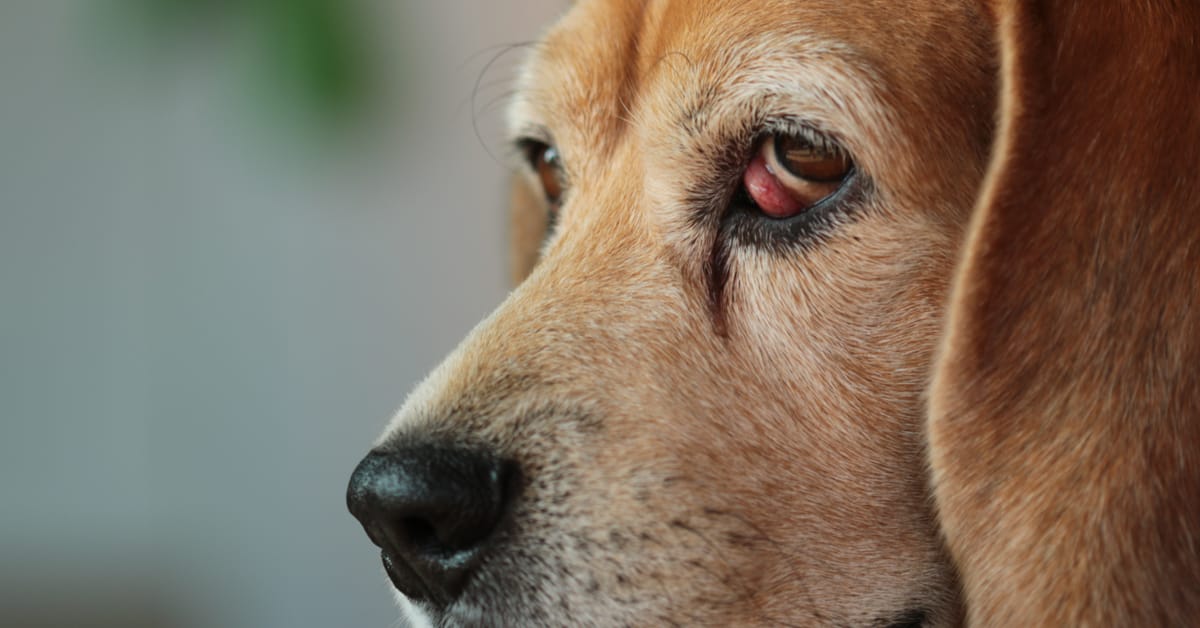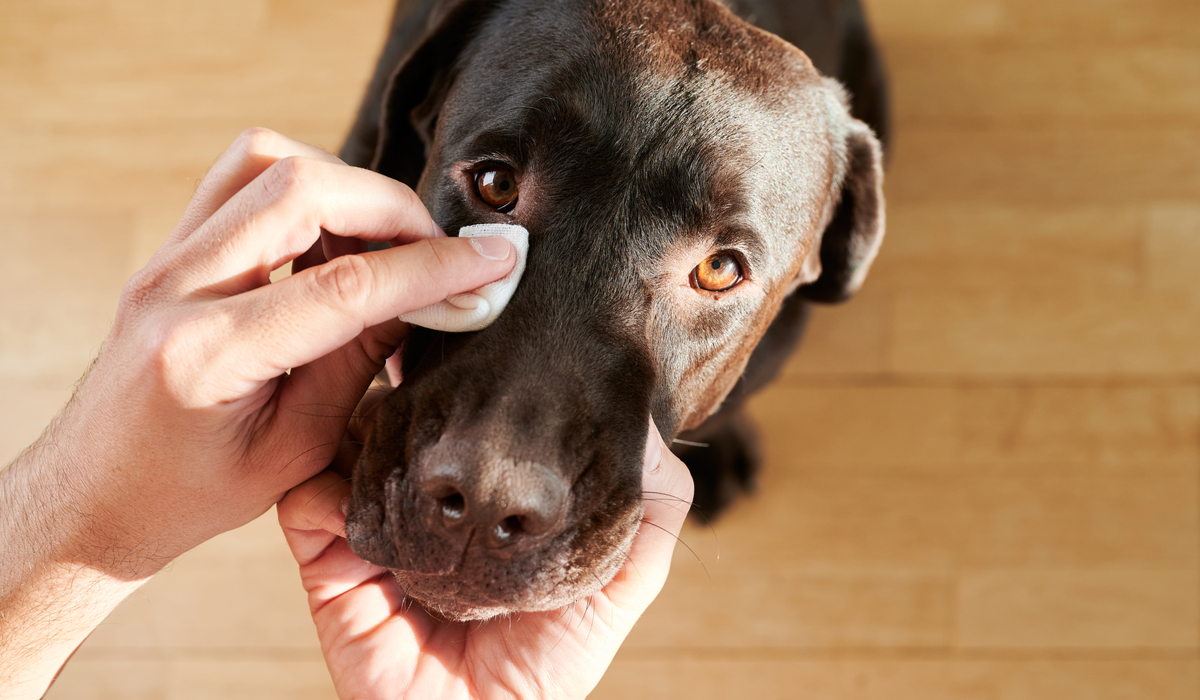Ever see a bulldog with a pink bubble in the corner of the eye? Chances are, that’s a cherry eye. This red, swollen mass has many names in medical circles. One of those names is a third eyelid prolapse. But to the rest of us, it’s a “cherry eye” and it looks awful.
If you’re like a lot of pet parents, you have questions. You want to know:
- What is this so-called cherry eye in dogs?
- What are the causes of cherry eye?
- Is it painful?
- What can you do about it?
- Does it affect some dog breeds more than others?
Let’s find out.
What Causes the Cherry Eye in Dogs?

What is cherry eye? As mentioned, this eye mass goes by several medical names. Veterinarians usually refer to it as a third eyelid prolapse, a prolapsed gland of the third eyelid, or the nictitans gland prolapse.
Let’s start with the word prolapse. It refers to a body part that’s drooping or out of place. In the case of the so-called cherry eye in dogs, it’s a tear duct that’s popped out of place.
The nictitans gland produces tears in your dog’s eye. Tears, as you know, are important for eye health because they help wash away dust and other debris. They also help the eyes stay healthy with good levels of oxygen.
This means when the connective tissue holding the tear duct in place collapses, the gland has trouble doing its job. Then, it sits like a red bulbous mass in the lower eyelid.
Veterinary ophthalmologists often call this tear gland a “nictitating membrane.” This membrane is in your pup’s lower eyelid which is why you see the “cherry” rising out of the lower lid. The ligaments holding this gland in place have weakened and the resulting prolapsed gland swells out of the inner corner of the eye in a round and red mass — hence the term “cherry eye.”
The third eyelid
Did you know that dogs have a third eyelid? In most dogs, you don’t notice a dog’s third eyelid because it’s hidden within the eye structure. However, when your pup has a weak ligament in the eye, this gland can shift. That’s what you see as a round pink area in the corner of the eye.
You can think of it as if you hung a birthday banner on the wall but only had old tape that was losing its sticky quality. It wouldn’t take long before the banner drooped. That’s what’s happening with your dog’s prolapsed gland.
That’s not to say the gland will droop further. It tends to stay in the lower corner of the eye. Sometimes it returns to its original location on its own, but usually, it requires surgery.
Certain breeds are predisposed to this condition of the nictitating membrane. As a doting pet parent, you know it’s ugly. But is it painful, and what can you do about it?
Which Dog Breeds Are Affected by Cherry Eye?

Cherry eye tends to affect certain dog breeds more than others. For example, the breeds of dogs who commonly get ocular issues like keratoconjunctivitis sicca or cherry eye are English bulldogs, beagles, Boston terriers, bloodhounds, pugs, Shih Tzus, Cocker Spaniels, Lhasa Apsos, and Mastiffs.
Now that you know what it is and the breeds most at risk, you probably want to know if it’s painful.
Is Cherry Eye Painful?

Dr. Alex Crow, DVM at Buttercross Veterinary Center shared with Outward Hound:
“While cherry eye isn’t generally painful for dogs in itself, the potential complications of not treating this condition can lead to pain. Slight discomfort due to a prolapsed tear gland can lead to excessive rubbing, conjunctivitis and even ulcers developing on the cornea – all of which are painful.”
Additionally, the damaged prolapsed gland can affect the tear glands and lead to dry eye in your dog because many of the tear ducts are in these glands.
You might see your dog pawing at it which doesn’t help and can make the affected eye worse. Unfortunately, cherry eye in dogs is not something that heals on its own.
What’s the Treatment for a Prolapse of the Gland?

As you might guess, your veterinarian will likely recommend surgery for the affected eye or eyes. In some cases, dogs get cherry eye in both eyes.
There are different surgical techniques your veterinary ophthalmologist will use to put the third eyelid gland back in place.
Dr. Crow says, “the sooner the treatment is performed, the better the prognosis. Up to 50% of tear production comes from the nictitans gland, leaving treatment too long can lead to dry eye, conjunctivitis, and corneal ulceration.”
He says the most common surgical technique is the mucosal pocket technique. In this instance, the surgeon creates a pocket in the mucosal tissue at the back of the third eyelid. Then, they reposition and suture the third eyelid gland. Usually, the stitches dissolve safely and your dog’s eye is repaired. However, in some cases, your pup may have a re-prolapse, and repeat cherry eye surgery may be required.
Follow-up treatment requires medicated eye drops and anti-inflammatory lubricants. These reduce inflammation and infection plus keep the eye lubricated so your dog feels more comfortable.
Can You Prevent Cherry Eye and How?

Cherry eye in dogs is a genetic predisposition. It also usually affects young dogs less than 1 year in age. Because it’s an inherited situation, there’s nothing you can do on the prevention front.
Yet, if your pup has loose ligaments holding that third eyelid in place, you’ll want to schedule a veterinary appointment at the earliest signs of cherry eye. The symptoms of cherry eye in dogs are the pink or red mass in the corner of your dog’s eye. So you’ll know there’s something wrong.
Now that you know what to call it if it does occur in your pup, you’ll know what it is and that scheduling a veterinarian appointment is your best next step. While cherry eye in dogs isn’t dangerous on its own, it can damage your dog’s eye health if ignored.
Are you a dog owner with a dog breed susceptible to cherry eye?

